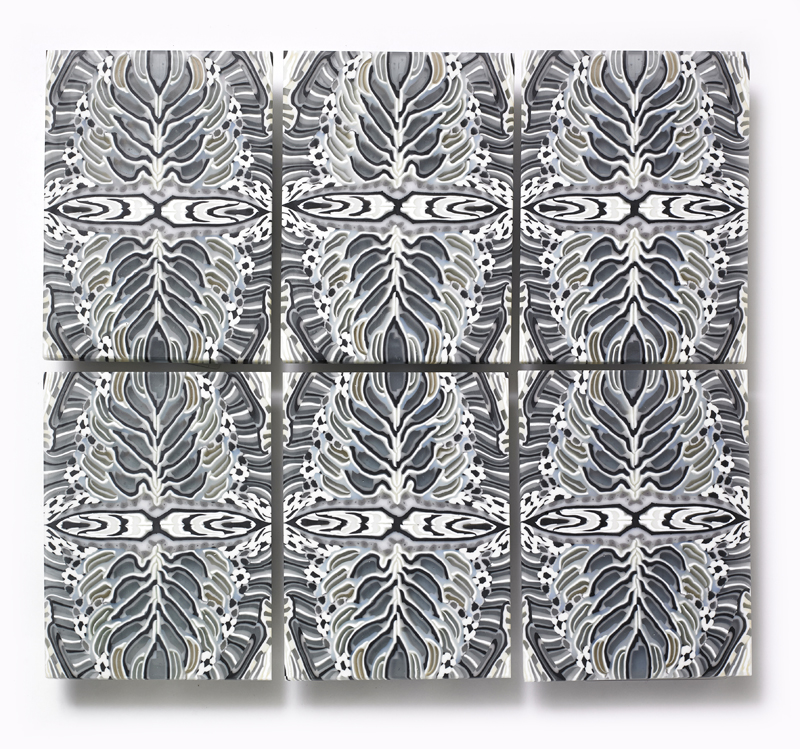
By Kurt Shaw
Saturday, Dec. 13, 2014, 8:30 p.m.
Featuring works on the cutting edge of kiln-formed glass, “Emerge/Evolve,” is the first exhibit at the Pittsburgh Glass Center dedicated solely to this technique.
Kiln-formed glass objects are made with glass that has been tested to be compatible for fusing when heated in a kiln.
The works on display are by 11 artists from around the world and were selected from current and past exhibitors in “Emerge 2014,” Bullseye Glass Co.’s eighth biennial kiln-glass exhibition for emerging artists. Based in Portland, Ore., Bullseye manufactures clear and colored billets used for glass casting.
The works are ambitious, to say the least.
For example, visitors will be immediately struck by Kate Clements’ untitled wall installation, which is an assemblage of more than 40 separate lace-like parts that can be reconfigured to the size and space in which it is installed.
“It was the most challenging work in the exhibition to install,” says glass-center marketing director Paige Ilkhanipour.
Each panel is composed of fused glass frit, or granules, and is extremely thin and delicate in many areas. While the pieces are quite stable as a whole, the utmost care had to be taken to handle each piece with two hands at all times.
Clements says the Amber Room and the front gate at the Catherine Palace in St. Petersburg, Russia, were the inspiration for the decorative nature of the piece. It takes the architecture of the palace and translates it into a glass wall or barrier as a stand-in for the real thing. These imitations and absences act as a veil of protection that is, ultimately, removed when the viewer discovers that the materials are standing in for something else.
“The amber-colored glass can never be the lusciousness of real amber,” Clements says, “and it can’t transcend to being gold, either.”
In this way, the piece lures the viewer in but, ultimately, fails to be what it is attempting to be.
“I enjoy that the viewer of the work can’t tell that it is glass right away,” says Clements, who is in her final year of the master of fine arts in glass program at the Tyler School of Art in Philadelphia. “When they realize it’s glass, there is sort of an ‘ah ha’ moment that then can make the viewer uncomfortable in the sense that they are now close to a very large, yet fragile, object.”
Martie Negri of Mamaroneck, N.Y., displays a multipaneled, fractal-inspired piece, “Threshold 4,” which is made with the centuries-old millefiori technique, a glassworking technique that produces distinctive decorative patterns on glassware.
“This series of work, ‘Thresholds,’ grew quite naturally from my earlier work with millefiori, which means a thousand flowers,” says Negri, who began her career as a painter and textile designer. “My millefiori was inspired by impressionist painting and was somewhat representational.”
Negri says this new work has been enlarged and abstracted from those earlier forms.
“To me, the repeating patterns reminded me of tile work, or the arabesque of traditional tribal rugs, and my association to those forms was tiled entryways, a door opening to a new space, a foyer, an interior space which is welcoming,” she says.
We all look for patterns, Negri says, which arise from within ourselves to help us to make order of the chaos in our lives.
“I like to think with my hands; in doing so, I’ve discovered that, every so often, you find ordinary magic in everyday life,” she says.
Nathan Sandberg of Portland, Ore., says the works that he has on display at Pittsburgh Glass Center are in response to his constant observation of the manmade environment that surrounds us all.
“Many people choose nature, the pretty sunset, flowers, trees, (landscape) as their inspiration when creating,” Sandberg says. “I propose that there are many other manmade resources available.”
Thus, the accidental arrangements of color, texture and form that exist in all cities constantly inform his work.
“The buildings we build, the roads that get us from here to there, the cracks in the sidewalk are all worthy subjects to me,” he says. “They were never meant to be considered, just used, but I suggest otherwise.”
And so, pieces like “Paver 5,” which is a heavily textured block of kiln-formed glass, allude to many of the manmade works in our environment, which Sandberg contends are worth looking at and appreciating.
“I’m hoping that my works make people think of, and appreciate, the manmade world around them and that they may become more aware of their surroundings,” he says.
Read more: http://triblive.com/aande/museums/7341277-74/glass-center-says#ixzz3PVPbd5Ik
Follow us: @triblive on Twitter | triblive on Facebook